TOYOTA CAMRY 2013 XV50 / 9.G Quick Reference Guide
Manufacturer: TOYOTA, Model Year: 2013, Model line: CAMRY, Model: TOYOTA CAMRY 2013 XV50 / 9.GPages: 32, PDF Size: 1.91 MB
Page 21 of 32
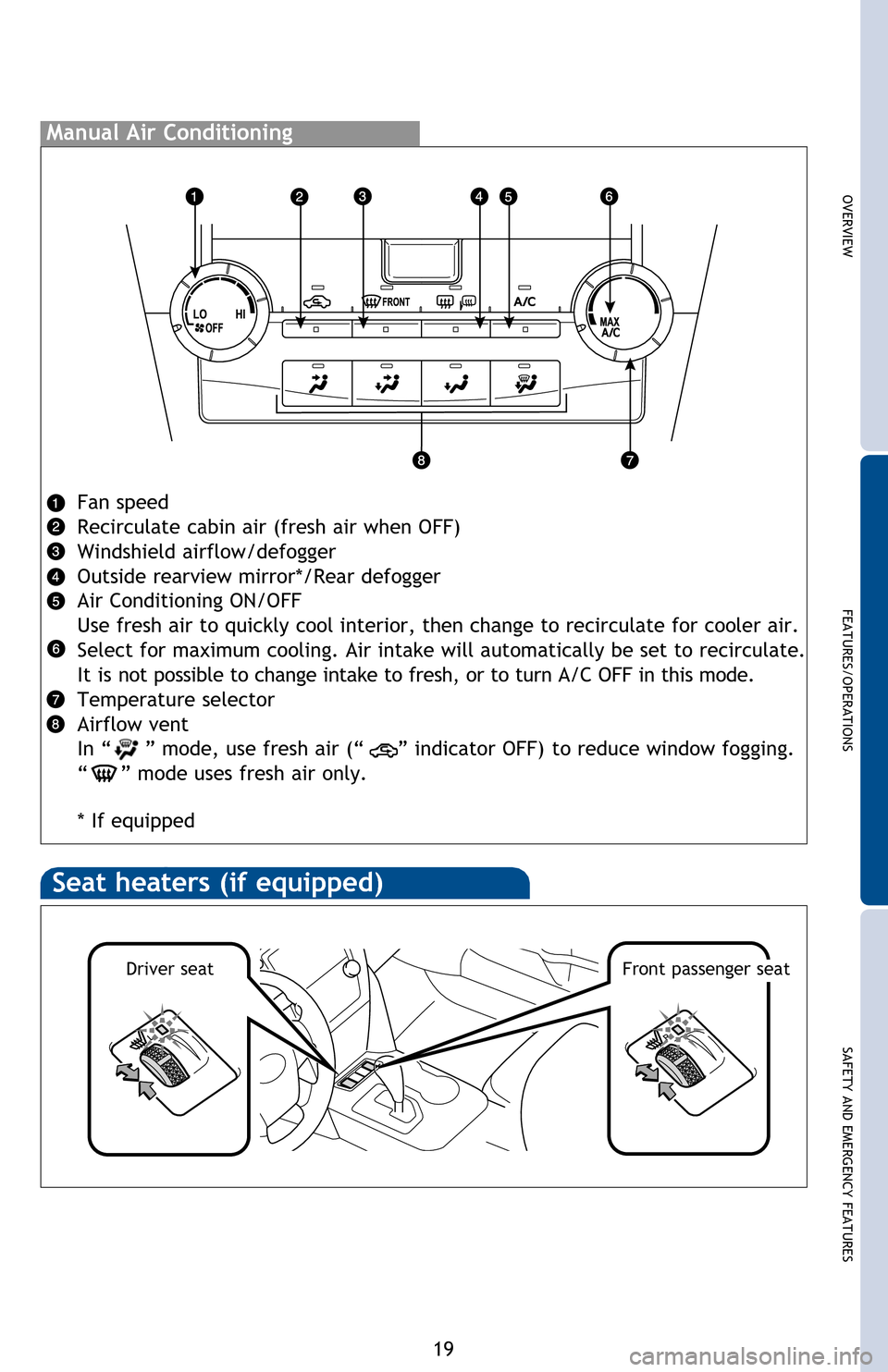
OVERVIEW
FEATURES/OPERATIONS
SAFETY AND EMERGENCY FEATURES
19
Automatic climate control ON
Adjusting the temperature setting will cause the airflow vents, air intake and
fan to adjust automatically.
Temperature selector (driver side)
Temperature selector (passenger side)
“DUAL” button
Indicator ON: Separate temperature settings for driver and passengers.
Indicator OFF: Synchronized temperature settings for driver and passengers.
Air Conditioning ON/OFF
Outside rearview mirror/Rear defogger
Airflow vent
In “
” or “” mode, use fresh air (“” indicator OFF) to reduce window
fogging.
Windshield airflow/defogger
Fan speed
Recirculate cabin air (fresh air when OFF)
Climate control OFF
Manual Air Conditioning
Fan speed
Recirculate cabin air (fresh air when OFF)
Windshield airflow/defogger
Outside rearview mirror*/Rear defogger
Air Conditioning ON/OFF
Use fresh air to quickly cool interior, then change to recirculate for cooler air.
Select for maximum cooling. Air intake will automatically be set to recirculate.
It is not possible to change intake to fresh, or to turn A/C OFF in this mode.\
Temperature selector
Airflow vent
In “ ” mode, use fresh air (“ ” indicator OFF) to reduce window fogging.
“
” mode uses fresh air only.
* If equipped
Seat heaters (if equipped)
3- 5. Other interior features
Sea t hea ters�
Driver seatFront passenger seat
127601_2013Camry_TEXT.indd 1911/21/12 4:14 PM
Page 22 of 32
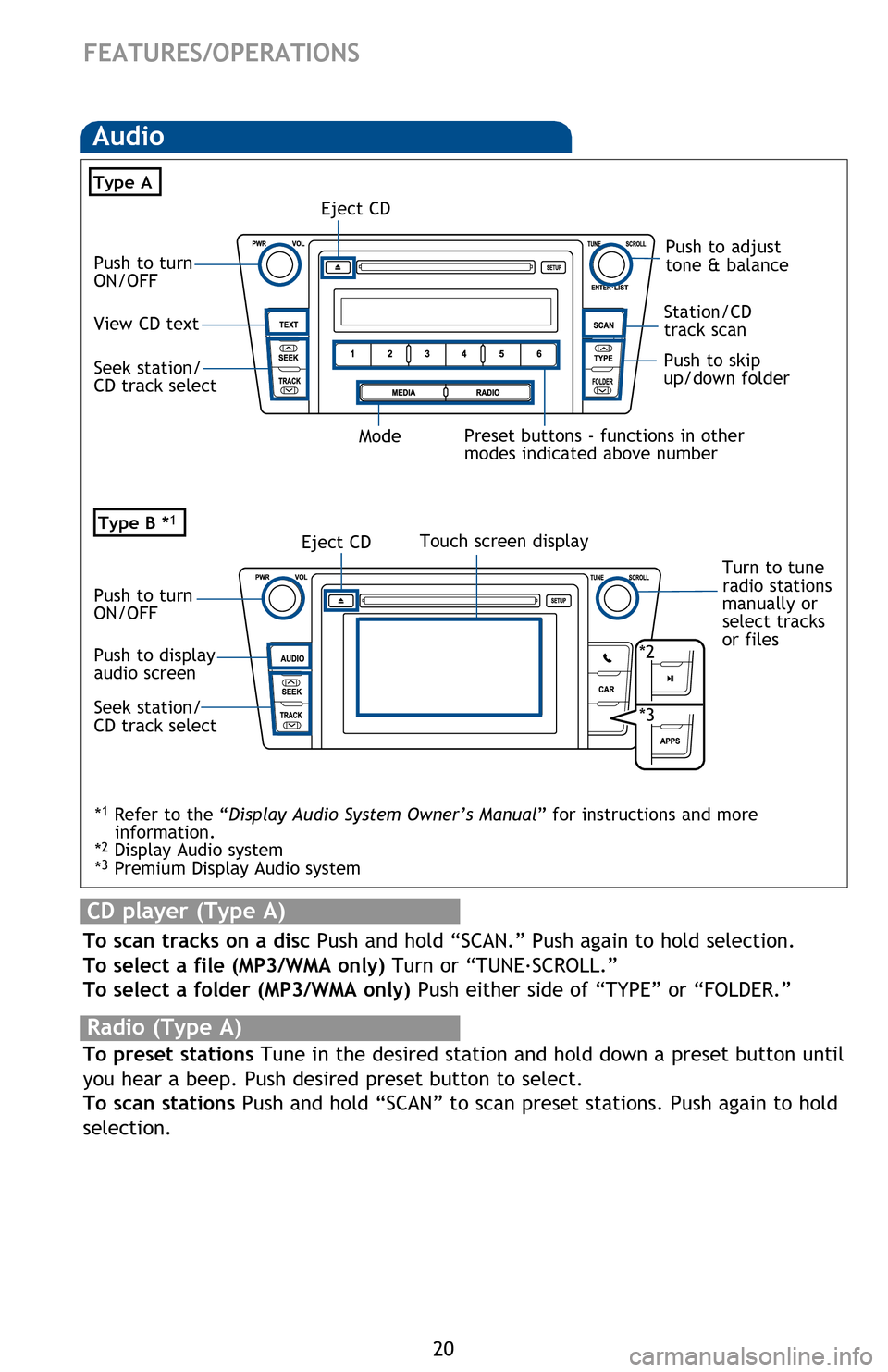
20
Steering wheel switches (if equipped)
“ ”
Use to search within the selected audio medium (radio, CD, iPod, etc.).
“MODE”
Push to turn audio ON and select an audio mode. Push and hold to mute/
unmute or pause/resume audio.
iPod
®/USB portBy connecting a USB-compatible portable audio device or USB memory to the USB port, you can listen to music from the portable audio device or USB memory
through the vehicle’s speaker system.
AUX port
By inserting a mini plug into the AUX port, you can listen to music from a portable
audio device through the vehicle’s speaker system while in AUX mode.
FEATURES/OPERATIONS
Audio
CD player (Type A)
To scan tracks on a disc Push and hold “SCAN.” Push again to hold selection.
To select a file (MP3/WMA only) Turn or “TUNE.
SCROLL.”
To select a folder (MP3/WMA only) Push either side of “TYPE” or “FOLDER.”
Type B *1
Eject CD
Push to turn
ON/OFF Push to adjust
tone & balance
Seek station/
CD track select Station/CD
track scan
Mode Preset buttons - functions in other
modes indicated above number
View CD text
Type A
Radio (Type A)
To preset stations
Tune in the desired station and hold down a preset button until
you hear a beep. Push desired preset button to select.
To scan stations Push and hold “SCAN” to scan preset stations. Push again to hold
selection.
Push to skip
up/down folder
Touch screen display
Push to display
audio screen Push to turn
ON/OFFEject CD Turn to tune
radio stations
manually or
select tracks
or files
Seek station/
CD track select
*2
*3
*
1 Refer to the “Display Audio System Owner’s Manual ” for instructions and more
information.
*
2 Display Audio system
*3 Premium Display Audio system
iPod®/USB/AUX port
127601_2013Camry.indd 2011/19/12 10:30 PM
Page 23 of 32
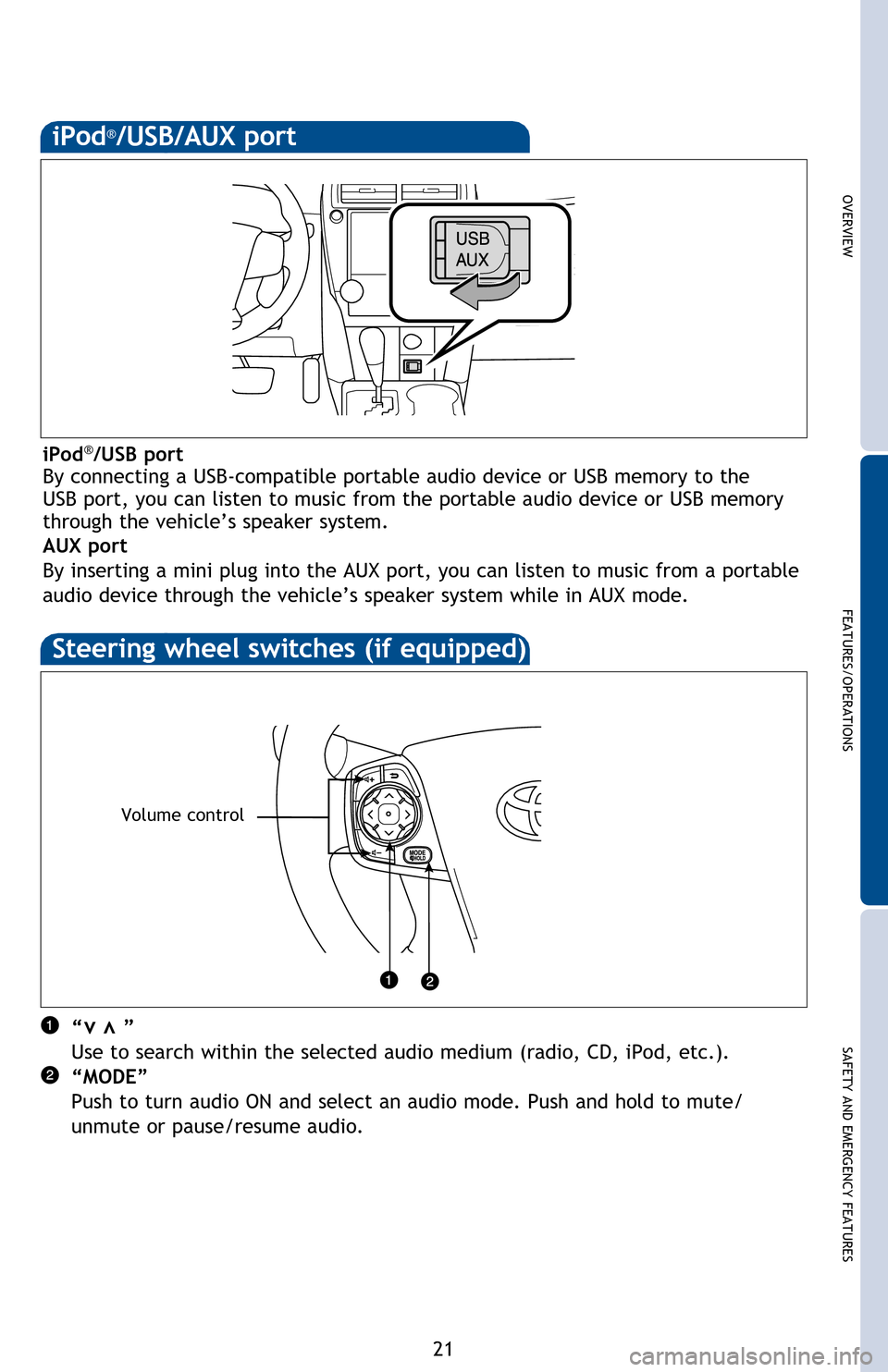
OVERVIEW
FEATURES/OPERATIONS
SAFETY AND EMERGENCY FEATURES
21
Steering wheel switches (if equipped)
“ ”
Use to search within the selected audio medium (radio, CD, iPod, etc.).
“MODE”
Push to turn audio ON and select an audio mode. Push and hold to mute/
unmute or pause/resume audio.vv
Volume control
iPod®/USB port
By connecting a USB-compatible portable audio device or USB memory to the
USB port, you can listen to music from the portable audio device or USB memory
through the vehicle’s speaker system.
AUX port
By inserting a mini plug into the AUX port, you can listen to music from a portable
audio device through the vehicle’s speaker system while in AUX mode.
To scan tracks on a disc Push and hold “SCAN.” Push again to hold selection.
To select a file (MP3/WMA only) Turn or “TUNE .
SCROLL.”
To select a folder (MP3/WMA only) Push either side of “TYPE” or “FOLDER.”
To preset stations Tune in the desired station and hold down a preset button until
you hear a beep. Push desired preset button to select.
To scan stations Push and hold “SCAN” to scan preset stations. Push again to hold
selection.
Turn to tune
radio stations
manually or
select tracks
or files
*
1 Refer to the “Display Audio System Owner’s Manual ” for instructions and more
information.
*
2 Display Audio system
*3 Premium Display Audio system
iPod®/USB/AUX port
127601_2013Camry.indd 2111/19/12 10:30 PM
Page 24 of 32
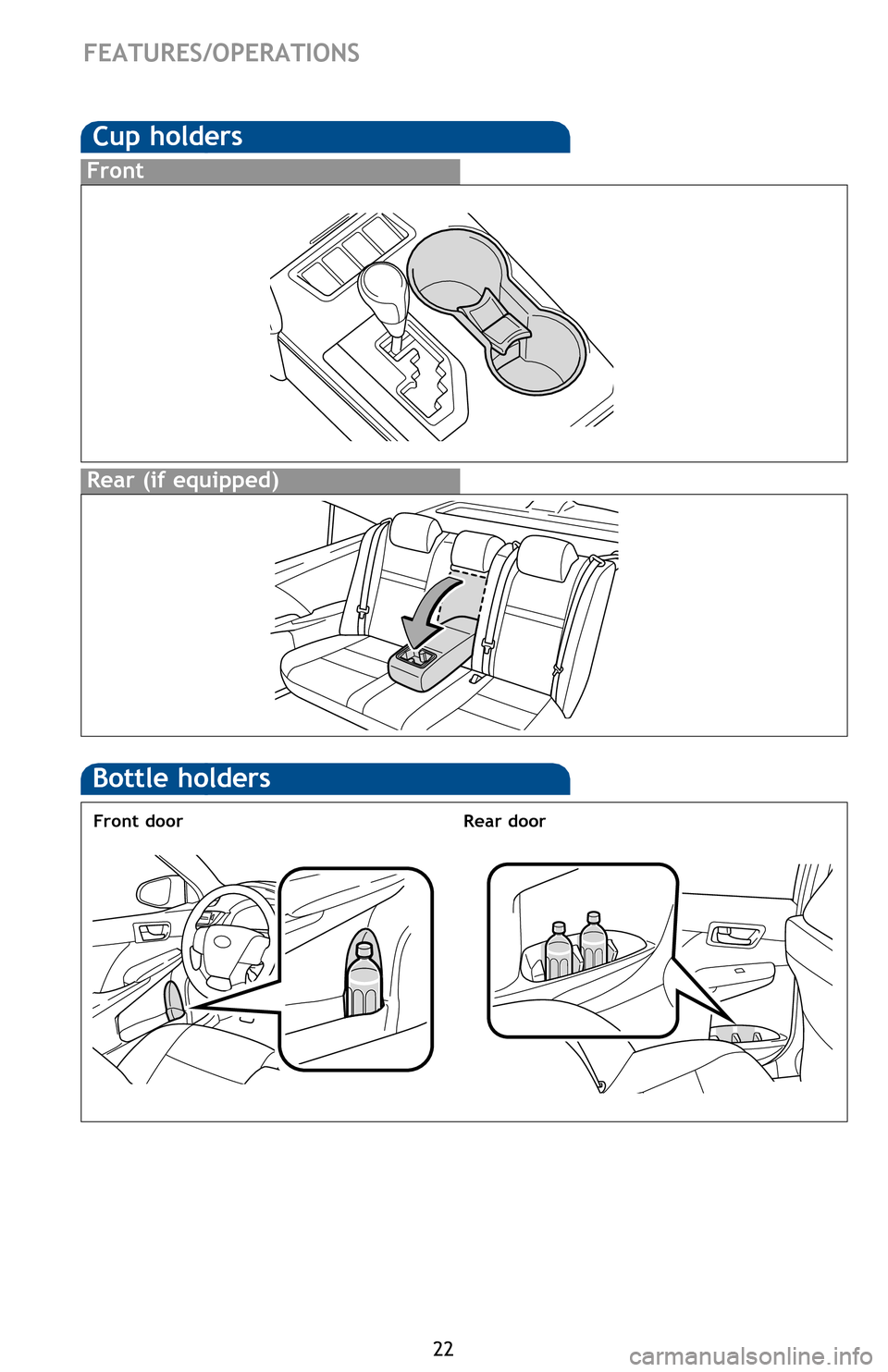
22
Rear (if equipped)
FEATURES/OPERATIONS
Cup holders
Front
Door locks
SAFETY AND EMERGENCY FEATURES
Moving the lever to “LOCK” will allow the door to be opened only from the outside.
Rear door
Doors-Child safety locks
Bottle holders
Rear doorFront door
127601_2013Camry.indd 2211/19/12 10:30 PM
Page 25 of 32
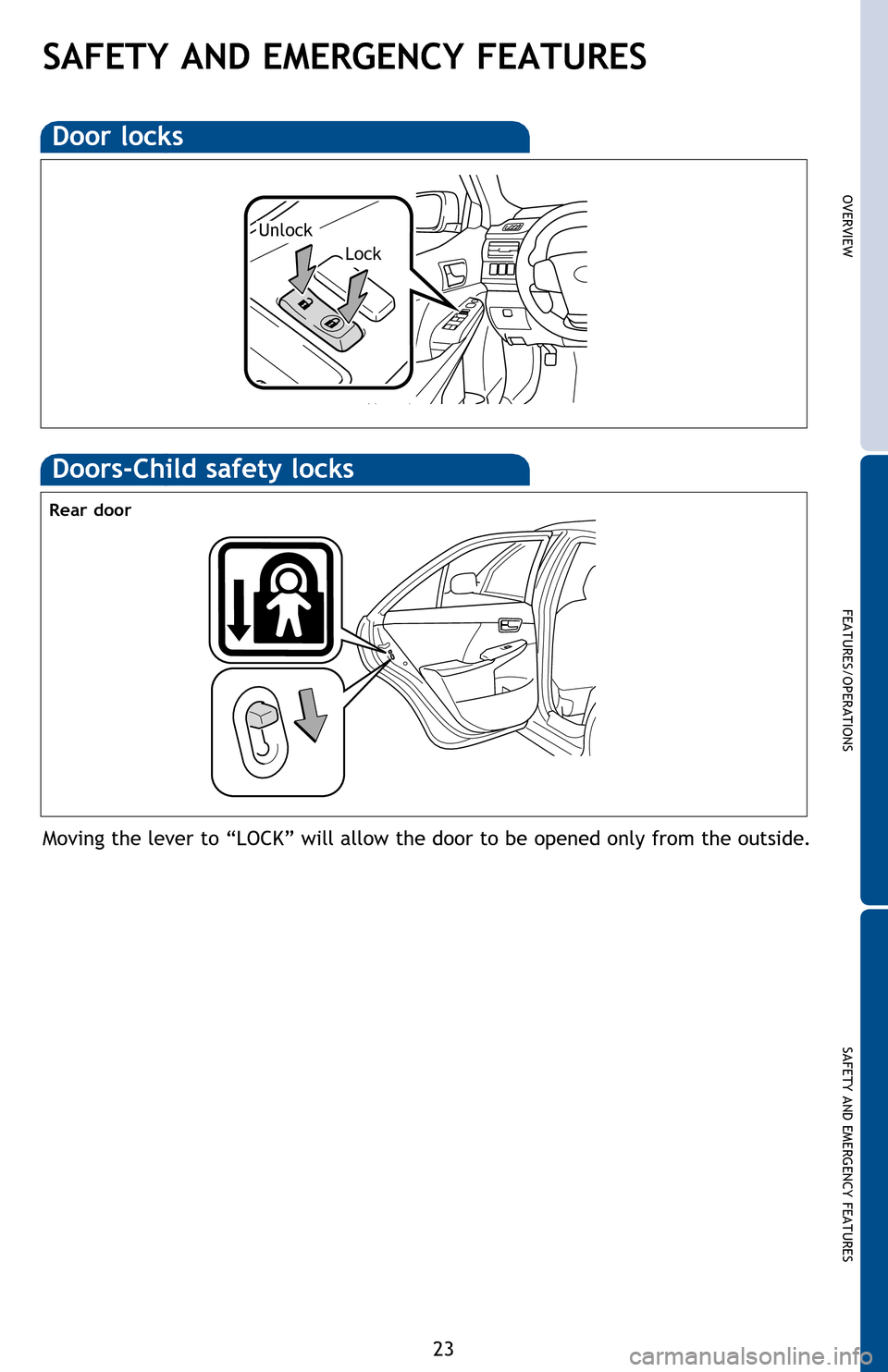
OVERVIEW
FEATURES/OPERATIONS
SAFETY AND EMERGENCY FEATURES
23
Door locks
Lock
Unlock
SAFETY AND EMERGENCY FEATURES
Moving the lever to “LOCK” will allow the door to be opened only from the outside.
Rear door
Doors-Child safety locks
127601_2013Camry.indd 2311/19/12 10:30 PM
Page 26 of 32
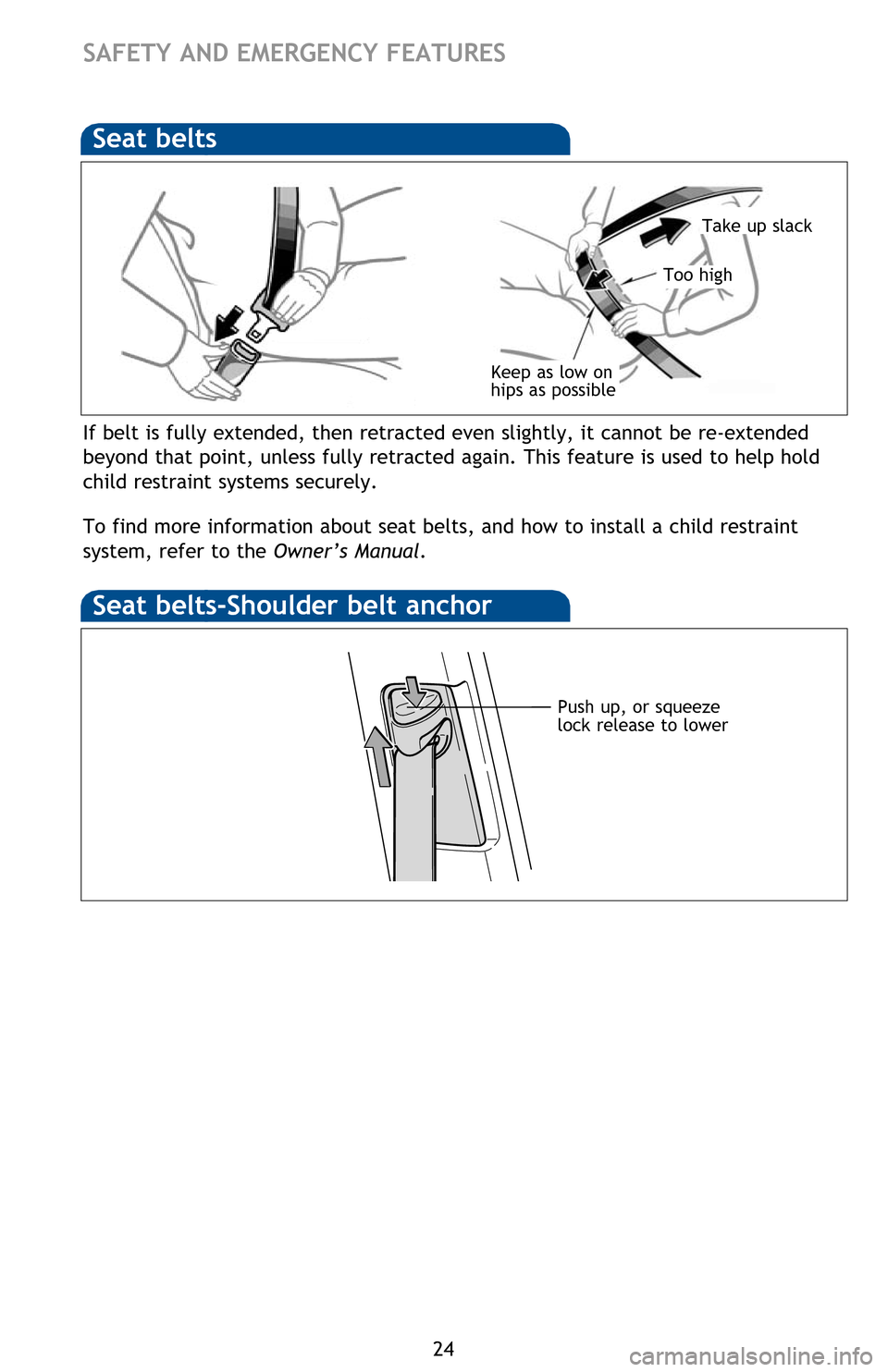
24
SAFETY AND EMERGENCY FEATURES
Push up, or squeeze
lock release to lower
Seat belts-Shoulder belt anchor
Spare tire & tools
Tool location
Jack
Jack handle
Luggage floor cover
Wheel nut wrench
Spare tire
Removing the spare tire
Trunk-Internal release
(1)
Refer to the Owner’s Manual for tire changing and jack positioning procedures.
If belt is fully extended, then retracted even slightly, it cannot be re-extended
beyond that point, unless fully retracted again. This feature is used to help hold
child restraint systems securely.
To find more information about seat belts, and how to install a child restraint
system, refer to the Owner’s Manual.
Keep as low on
hips as possible
Take up slack
Too high
Seat belts
127601_2013Camry.indd 2411/19/12 10:30 PM
Page 27 of 32

OVERVIEW
FEATURES/OPERATIONS
SAFETY AND EMERGENCY FEATURES
25
Spare tire & tools
Tool location
Jack
Jack handle
Luggage floor cover
Wheel nut wrench
Spare tire
Removing the spare tire
(1) Remove the tool tray.
(2) Loosen the center fastener that secures the spare tire.
Trunk-Internal release
Pull up
(1)
(2)
Refer to the Owner’s Manual for tire changing and jack positioning procedures.
If belt is fully extended, then retracted even slightly, it cannot be re-extended
beyond that point, unless fully retracted again. This feature is used to help hold
child restraint systems securely.
To find more information about seat belts, and how to install a child restraint
system, refer to the Owner’s Manual.
Take up slack
127601_2013Camry.indd 2511/19/12 10:31 PM
Page 28 of 32
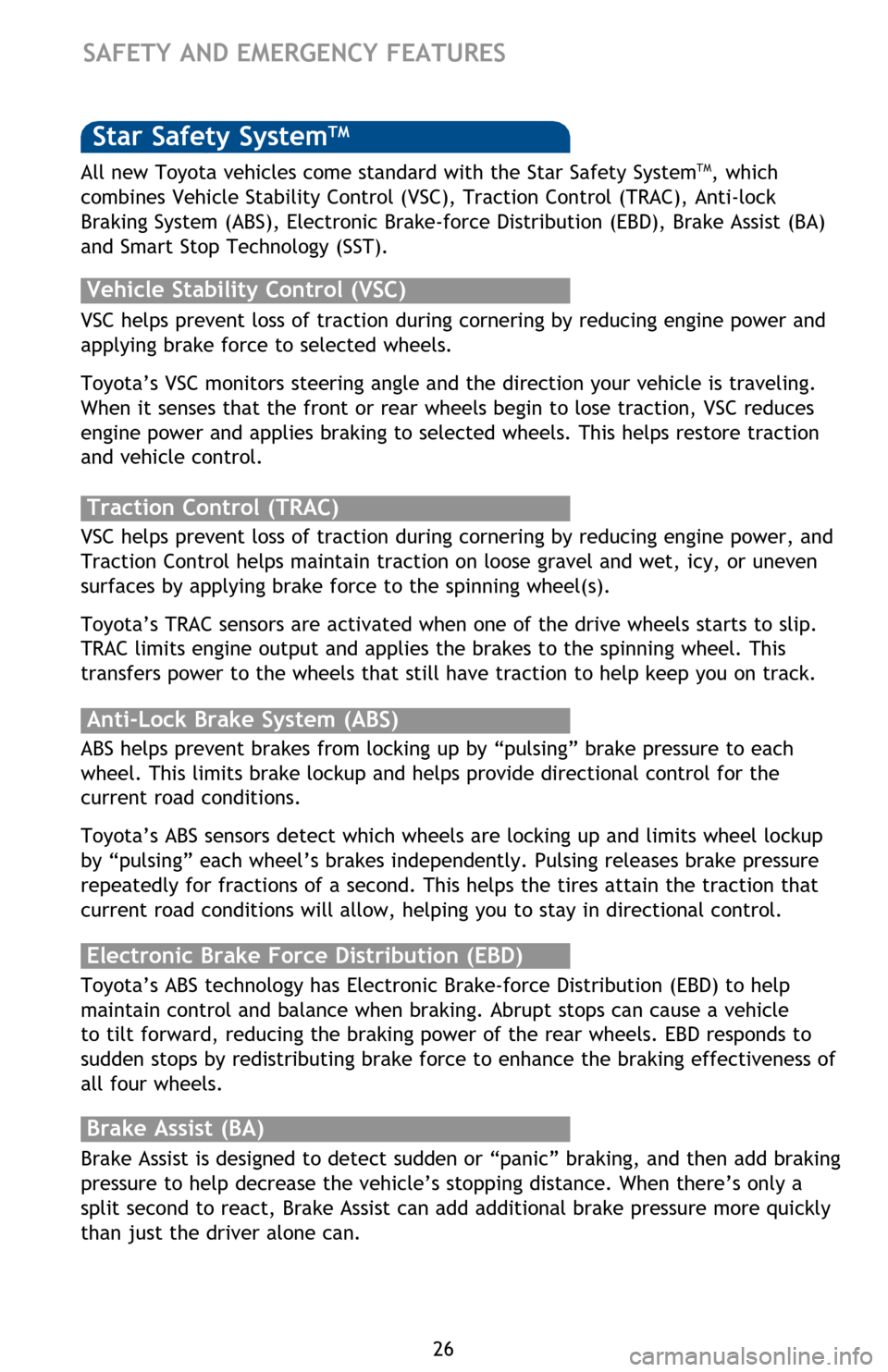
26
Star Safety SystemTM
VSC helps prevent loss of traction during cornering by reducing engine power and
applying brake force to selected wheels.
Toyota’s VSC monitors steering angle and the direction your vehicle is traveling.
When it senses that the front or rear wheels begin to lose traction, VSC reduces
engine power and applies braking to selected wheels. This helps restore traction
and vehicle control.
Vehicle Stability Control (VSC)
Anti-Lock Brake System (ABS)
ABS helps prevent brakes from locking up by “pulsing” brake pressure to each
wheel. This limits brake lockup and helps provide directional control for the
current road conditions.
Toyota’s ABS sensors detect which wheels are locking up and limits wheel lockup
by “pulsing” each wheel’s brakes independently. Pulsing releases brake pressure
repeatedly for fractions of a second. This helps the tires attain the traction that
current road conditions will allow, helping you to stay in directional control.
Brake Assist (BA)
Brake Assist is designed to detect sudden or “panic” braking, and then add braking
pressure to help decrease the vehicle’s stopping distance. When there’s only a
split second to react, Brake Assist can add additional brake pressure more quickly
than just the driver alone can. VSC helps prevent loss of traction during cornering by reducing engine power, and
Traction Control helps maintain traction on loose gravel and wet, icy, or uneven
surfaces by applying brake force to the spinning wheel(s).
Toyota’s TRAC sensors are activated when one of the drive wheels starts to slip.
TRAC limits engine output and applies the brakes to the spinning wheel. This
transfers power to the wheels that still have traction to help keep you on track.
Traction Control (TRAC)
Electronic Brake Force Distribution (EBD)
Toyota’s ABS technology has Electronic Brake-force Distribution (EBD) to help
maintain control and balance when braking. Abrupt stops can cause a vehicle
to tilt forward, reducing the braking power of the rear wheels. EBD responds to
sudden stops by redistributing brake force to enhance the braking effectiveness of
all four wheels.
SAFETY AND EMERGENCY FEATURES
All new Toyota vehicles come standard with the Star Safety SystemTM, which
combines Vehicle Stability Control (VSC), Traction Control (TRAC), Anti-lock
Braking System (ABS), Electronic Brake-force Distribution (EBD), Brake Assist (BA)
and Smart Stop Technology (SST).
There are two types of Toyota floor mats: carpeted and all-weather. Each vehicle
has model-specific floor mats. Installation is easy.
To keep your floor mat properly positioned, follow these steps:
• Only use floor mats designed for your specific model.
• Use only one floor mat at a time, using the retaining hooks to keep the mat in place.
• Install floor mats right side up.
Floor mat installation
Smart Stop Technology automatically reduces driving torque when the accelerator
and brake pedals are pressed simultaneously under certain conditions.
SST engages when the accelerator is depressed first and the brakes are applied
firmly for longer than one-half second at speeds greater than five miles per hour.
SST doesn’t engage if the brake pedal is depressed before the accelerator pedal,
allowing vehicles to start on a steep hill and safely accelerate without rolling
backward.
Smart Stop Technology (SST)
127601_2013Camry.indd 2611/19/12 10:31 PM
Page 29 of 32
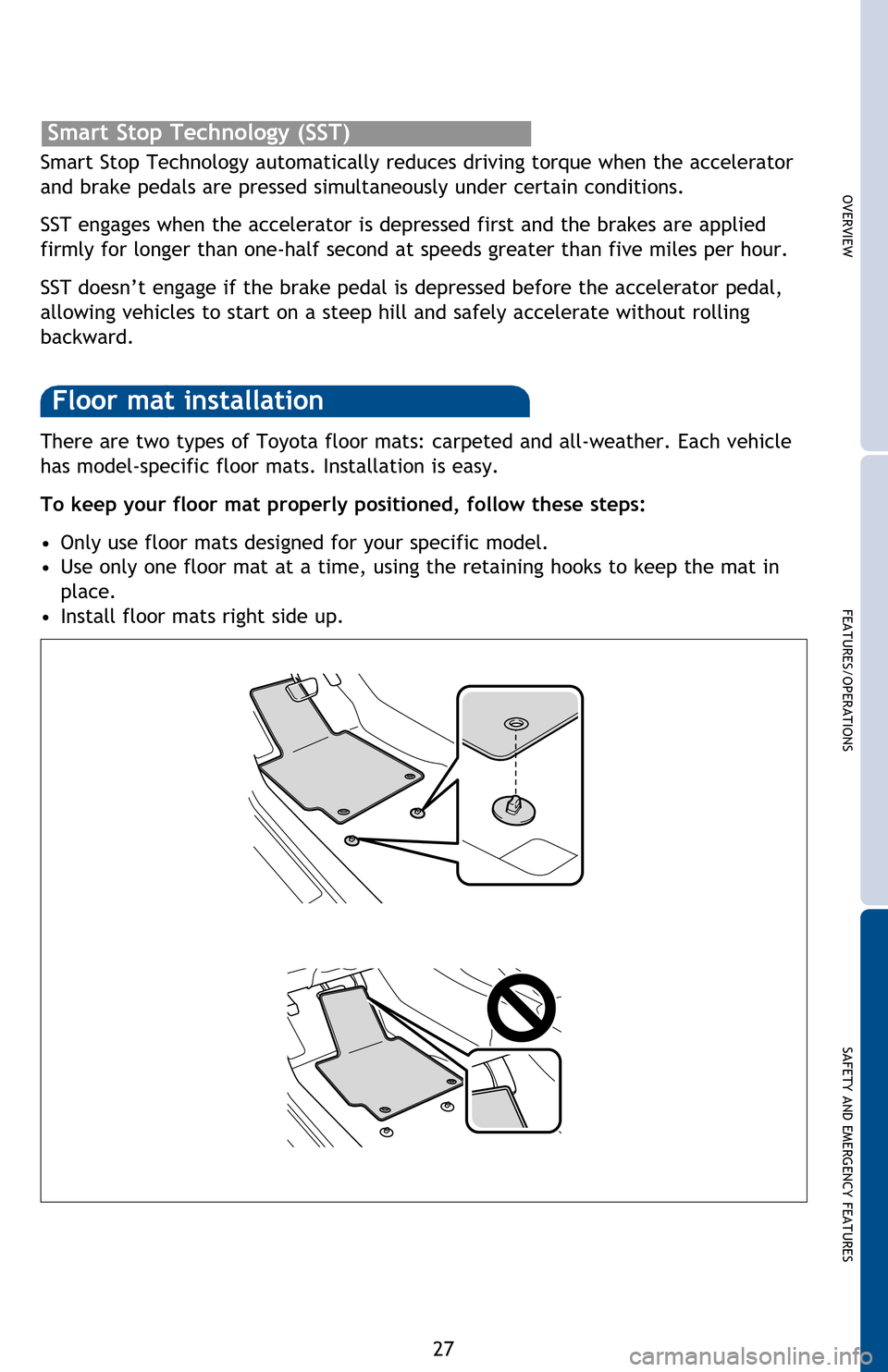
OVERVIEW
FEATURES/OPERATIONS
SAFETY AND EMERGENCY FEATURES
27
VSC helps prevent loss of traction during cornering by reducing engine power and
applying brake force to selected wheels.
Toyota’s VSC monitors steering angle and the direction your vehicle is traveling.
When it senses that the front or rear wheels begin to lose traction, VSC reduces
engine power and applies braking to selected wheels. This helps restore traction
and vehicle control.
ABS helps prevent brakes from locking up by “pulsing” brake pressure to each
wheel. This limits brake lockup and helps provide directional control for the
current road conditions.
Toyota’s ABS sensors detect which wheels are locking up and limits wheel lockup
by “pulsing” each wheel’s brakes independently. Pulsing releases brake pressure
repeatedly for fractions of a second. This helps the tires attain the traction that
current road conditions will allow, helping you to stay in directional control.
Brake Assist is designed to detect sudden or “panic” braking, and then add braking
pressure to help decrease the vehicle’s stopping distance. When there’s only a
split second to react, Brake Assist can add additional brake pressure more quickly
than just the driver alone can. VSC helps prevent loss of traction during cornering by reducing engine power, and
Traction Control helps maintain traction on loose gravel and wet, icy, or uneven
surfaces by applying brake force to the spinning wheel(s).
Toyota’s TRAC sensors are activated when one of the drive wheels starts to slip.
TRAC limits engine output and applies the brakes to the spinning wheel. This
transfers power to the wheels that still have traction to help keep you on track.
Toyota’s ABS technology has Electronic Brake-force Distribution (EBD) to help
maintain control and balance when braking. Abrupt stops can cause a vehicle
to tilt forward, reducing the braking power of the rear wheels. EBD responds to
sudden stops by redistributing brake force to enhance the braking effectiveness of
all four wheels.
SAFETY AND EMERGENCY FEATURES
All new Toyota vehicles come standard with the Star Safety SystemTM, which
combines Vehicle Stability Control (VSC), Traction Control (TRAC), Anti-lock
Braking System (ABS), Electronic Brake-force Distribution (EBD), Brake Assist (BA)
and Smart Stop Technology (SST).
There are two types of Toyota floor mats: carpeted and all-weather. Each vehicle
has model-specific floor mats. Installation is easy.
To keep your floor mat properly positioned, follow these steps:
• Only use floor mats designed for your specific model.
• Use only one floor mat at a time, using the retaining hooks to keep the mat in place.
• Install floor mats right side up.
Floor mat installation
Smart Stop Technology automatically reduces driving torque when the accelerator
and brake pedals are pressed simultaneously under certain conditions.
SST engages when the accelerator is depressed first and the brakes are applied
firmly for longer than one-half second at speeds greater than five miles per hour.
SST doesn’t engage if the brake pedal is depressed before the accelerator pedal,
allowing vehicles to start on a steep hill and safely accelerate without rolling
backward.
Smart Stop Technology (SST)
127601_2013Camry.indd 2711/19/12 10:31 PM
Page 30 of 32

28
NOTES
127601_2013Camry_TEXT.indd 2811/30/12 7:35 PM